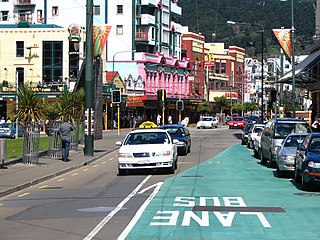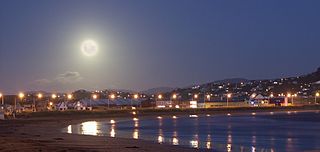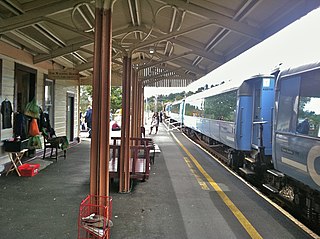
Lambton Quay is the heart of the central business district of Wellington, the capital city of New Zealand.
The Maadi Cup is the prize for the New Zealand Secondary Schools Boys' Under 18 Rowing Eights. More colloquially, it is the name given to the New Zealand Secondary Schools Rowing Regatta, at which the Maadi Cup is raced. The regatta is the largest school sports event in the Southern Hemisphere, with over 2,450 rowers from 123 secondary schools participating in 2021. The regatta is held annually in late March, alternating between the country's two main rowing venues: Lake Karapiro near Cambridge, and Lake Ruataniwha near Twizel.

Post Office Savings Bank, or very briefly PostBank, was a bank owned by the New Zealand Government as the government's postal savings system. The bank was established in 1867. It became PostBank in 1987 and was disestablished and the branches were rebranded when it was acquired by Australia and New Zealand Banking Group in 1989.

Te Aro is an inner-city suburb of Wellington, New Zealand. It comprises the southern part of the central business district including the majority of the city's entertainment district and covers the mostly flat area of city between The Terrace and Cambridge Terrace at the base of Mount Victoria.

Lyall Bay is a bay and suburb on the south side of the Rongotai isthmus in Wellington, New Zealand.
The following lists events that happened during 1866 in New Zealand.
The Scout Association of New Zealand's Sea Scouts are Scout Groups specialising in water-based activities. In 2017, there were around 900 Sea Scouts in New Zealand in 53 troops around the country.

The former Post and Telegraph Building, now known as Chaffers Dock Apartments, is a building located in Wellington, New Zealand.

Kenneth James Boswell was a New Zealand rower who won a silver medal representing his country at the 1938 British Empire Games.

The Wellington Rowing Club is a rowing club situated on Wellington Harbour, New Zealand. The current building, is classified as a "Category I" historic place by the New Zealand Historic Places Trust.

Thomas Turnbull (1824–1907) was a notable New Zealand architect.

Mangere Aerodrome, named after a nearby suburb, was the original home of the Auckland Aero Club. It is now the site of Auckland Airport. Mangere Aerodrome's claim to fame was as the arrival point for New Zealand aviator, and aeroclub member, Jean Batten's solo flight from the United Kingdom in 1936. The RNZAF requisitioned the aerodrome from 1939 until 1944, renaming it RNZAF Station Mangere. In 1961, the Auckland Aero Club moved to Ardmore aerodrome and Mangere Aerodrome closed. The new Auckland Airport opened in 1965.

Evans Bay, located in Wellington Harbour, New Zealand, between the Miramar Peninsula and Hataitai, was the site of New Zealand's first patent slip and served as Wellington's international flying-boat terminal from 1938 until 1956. It is named after George Samuel Evans, an early Wellington settler.

Japan–New Zealand relations refers to the diplomatic relations between Japan and New Zealand. Both nations are members of APEC, Australia Group, CPTPP, Organization for Economic Co-operation and Development and the United Nations.

Ohakune railway station is a station on the North Island Main Trunk (NIMT), it served the town of Ohakune in the Manawatū-Whanganui region of New Zealand. It was called Ohakune Junction from 10 August 1926 until Raetihi Branch closed in 1968, to avoid confusion with Ohakune Town station on that branch. It was the second highest operating railway station in New Zealand, after National Park.

Tristan Freitas Hegglun was a New Zealand rower, rugby union player, and local-body politician. He rowed for his country at the 1950 British Empire Games, and won two national rowing titles. A front-row forward and lock, he played provincial rugby for both Wellington and Marlborough, and was involved in services matches during World War II. He later served as a Blenheim borough councillor.
Wellington Rowing Association is rowing's governing body in Wellington, New Zealand. Wellington Rowing Association is one of the 10 member associations comprising the New Zealand Rowing Association and shares the common purpose of fostering and promoting the sport of rowing in all its forms and classifications.

The Wanganui was an iron Brigantine Twin Boiler Screw steamer built by Gourlay Brothers & Co and launched in July 1863 for the Wanganui Steam Navigation Company for trade around the Wanganui region of New Zealand. The vessel served in this region up to 1873 when its ownership was transferred to Messrs Henry Houghton and Co., of Dunedin. In 1880 the vessel was transferred in to the Australian East coast service where it sank whilst entering Clarence River on 20 June 1880.

Gear Meat Company was a meat processing company with a large works that operated in Petone, New Zealand from 1874 until 1981 and was one of the major employers in Petone.

















